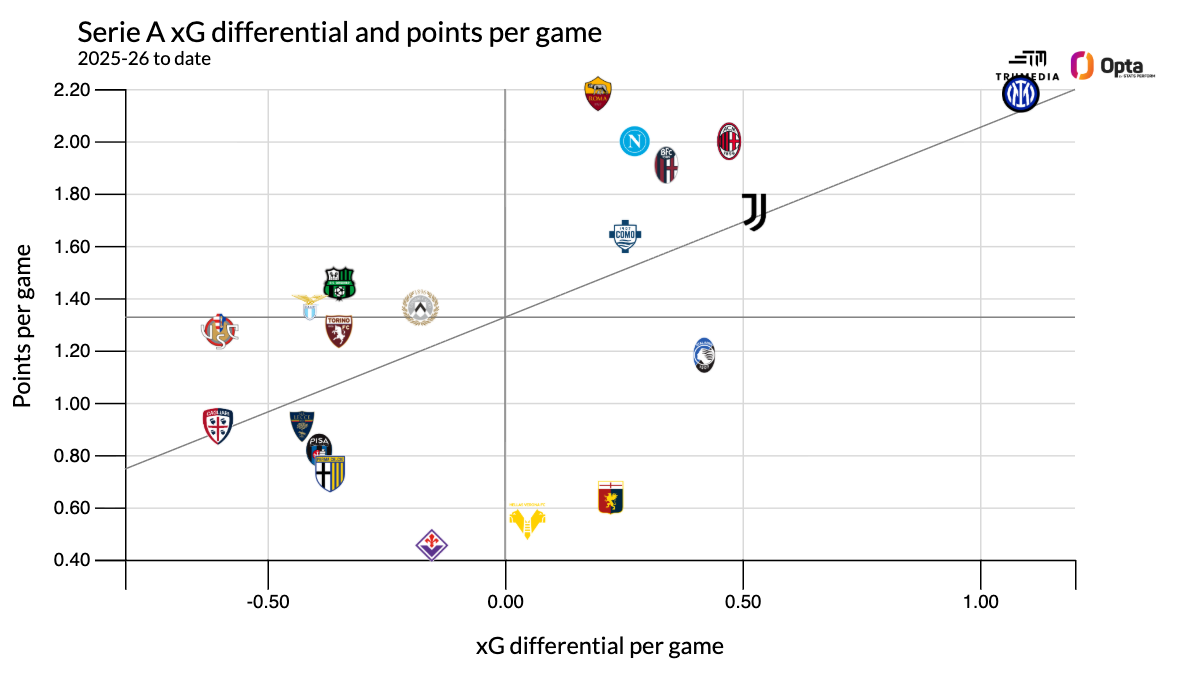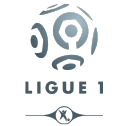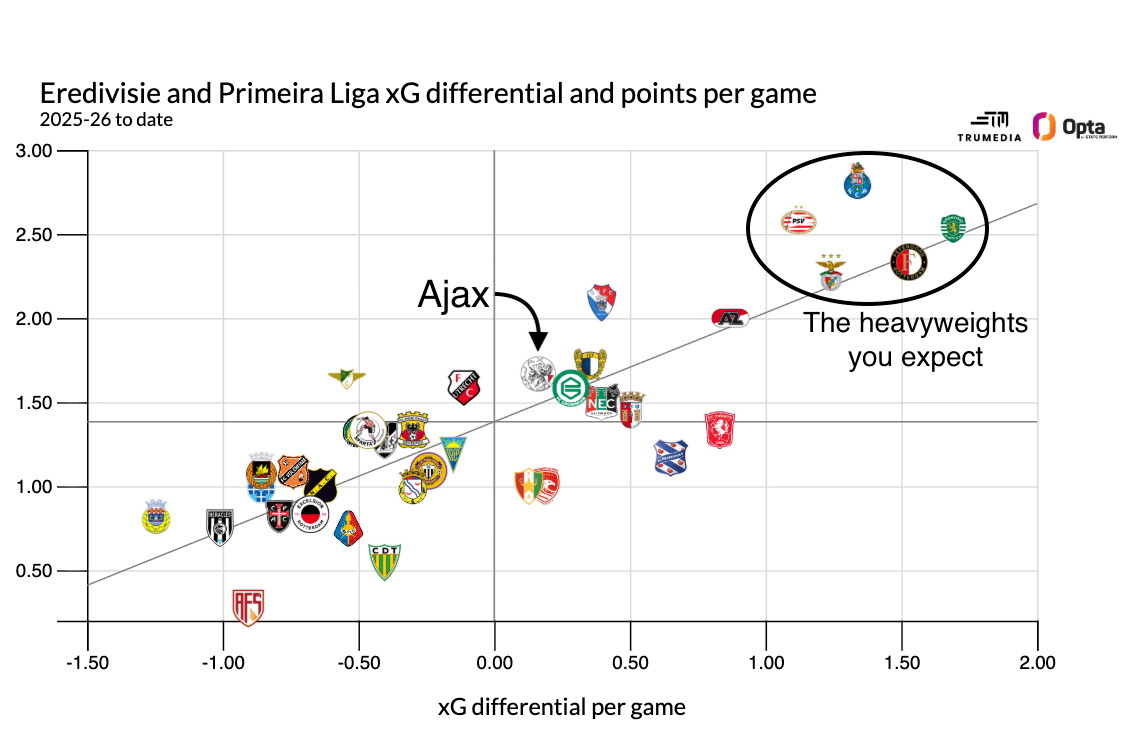We have officially reached the «nerd zone» of the 2025-26 European soccer season. It is said (by the nerds, of course) that it takes about 10 matches for expected goal (xG) figures to start telling you a semi-accurate, predictive story about a given team. We should probably think of that as more of a range of about eight to 15 games, but regardless, the European season has officially entered that range. France’s Ligue 1 and Spain’s LaLiga have each played 12 matchdays thus far, with England’s Premier League and Italy’s Serie A at 11, and Germany’s Bundesliga at 10.
It’s mid-November and the third international break of the season is upon us, and as we wait to see if Nigeria and Congo DR can keep their World Cup qualification hopes alive or if the mighty Faroe Islands can pull off a qualification miracle, now’s a pretty good time to step back and look at what the analytics are telling us about the club season to date.
Acknowledging that the best teams usually have the best finishers (and might therefore be likely to overachieve their xG figures a bit), that I’m choosing overall xG figures (and not non-penalty xG) for general data cleanliness purposes, and that injuries have obvious effects on what the data is telling us, here’s a league-by-league look at where things stand approximately 30% of the way through the 2025-26 campaign.
– Lucky or unlucky: How have Arsenal, Liverpool, others fared?
– Ranked: Best, worst 2025 summer transfers from Premier League and beyond
– Gyökeres, Isak, Sesko: What happened to the summer of strikers?
 Premier League: Arsenal are dynamite, but Haaland-reliant Man City could still spring a challenge
Premier League: Arsenal are dynamite, but Haaland-reliant Man City could still spring a challenge
Liverpool are currently the perfect example of why you wait until the 10-game-or-so mark to tell a story. In August, they beat Newcastle United 3-2 despite a minus-0.3 xG differential (xGD) and beat Arsenal 1-0 despite basically an xG toss-up (plus-0.04 xGD). In October, they lost to Chelsea and Manchester United by matching 2-1 scores despite a combined xGD of plus-2.4.
Randomness has hit pretty hard at Anfield, but with 11 matches in the bank, we can say that Liverpool’s standing in the table is about right: They’re fifth in xGD, and, with 18, they have the fifth-most points to date.

As you can see from the above chart comparing teams’ xGD to their points per game, Liverpool have achieved almost exactly what xG suggests they should have. And while they are eighth in the table because of goal differential, the other four teams in the 18-point club have overachieved thus far, as have fourth-place Sunderland at 19 points. All are solid regression candidates.
The top three places in the table are occupied by the teams with the top three xG differentials, which is reasonable, but Liverpool’s biggest competition for a spot in the top four might actually be Crystal Palace.
The Eagles are in 10th with 17 points, but they’re only two points out of the top four, and their plus-6.6 xGD to date is awfully close to that of third-place Chelsea (plus-7.0). They’ve had an awfully strange relationship with xG this season: They’ve scored just 14 goals from shots worth 19.3 xG, but they’ve also only allowed nine goals from shots worth 12.7. This has produced some strange results, including draws with Bournemouth (plus-2.4 xGD), Sunderland (plus-1.4) and Chelsea (minus-1.0). Regardless, they’re only a couple of points behind where they should be, and if they continue to create and allow the same quality of chances, they’ll be in the hunt for a Champions League spot.
At the top, Arsenal are in excellent position, with a four-point lead in the table and a cumulative plus-4.5 difference over Manchester City in xGD. You don’t need me to tell you they’ve been the best team in the league (and quite possibly in Europe) thus far, but trends suggest that City are improving quickly: Their average xGD over their first five matches was plus-0.60, but it’s risen to plus-0.96 over the past six. Six matches isn’t conclusive, but considering this is six-titles-in-eight-seasons City we’re talking about, we might be inclined to give them the benefit of the doubt.
City have been ridiculously reliant on Erling Haaland thus far — he has scored 14 league goals, and no one else has scored more than one for City (unless you include Burnley‘s Maxime Estève, who suffered a pair of own goals in City’s 5-1 win). But he’s also not scoring at a particularly ridiculous level given his history and shot quality. He has scored those 14 goals from shots worth 11.1 xG, which means he’s overachieving against xG by about 26%; he sustained that level of overachievement for the entire 2022-23 campaign.
Regression could still come — and who knows what happens if Haaland gets hurt — but if he’s on the pitch, City could threaten Arsenal.
 German Bundesliga: Bayern are breaking the trend line, and the top-four race could be dynamite
German Bundesliga: Bayern are breaking the trend line, and the top-four race could be dynamite
In the Premier League chart above, we got a nice, clean trend line. In the Bundesliga, Bayern Munich have dominated at such a level that it … broke the chart a bit.

Based on their ridiculous plus-2.0 xGD per match, Bayern should be averaging about 3.1 points per game, which is, of course, impossible. They hadn’t dropped points all season, in any competition, until last Saturday’s 2-2 draw with Union Berlin, and although that was a dreadful performance by their standards, they still finished with a plus-0.5 xGD.
We’re used to the Bavarian giants ruling the Bundesliga, but they rarely hit this level, and when they do it’s usually because they are humiliating the dregs of the league. Perhaps the scariest thing about their current level is that they’ve already played the teams currently in second (RB Leipzig), third (Borussia Dortmund), fifth (Bayer Leverkusen), sixth (Hoffenheim), seventh (Eintracht Frankfurt) and eighth (Werder Bremen). They won those six matches by a combined 22-2.
Since Bayern basically broke the chart above, let’s look at how the Bundesliga takes shape without them:

That’s a little cleaner, and it tells us that despite their fifth-place standing, Bayer Leverkusen are probably the second-best team in the league — especially considering their xGD is plus-1.0 per match since firing Erik ten Hag on Sept. 1 (and plus-1.3 against teams not named Bayern). Still, they’ve dropped more points than they should have, and there should be at least four other teams heavily involved in the race for a top-four finish.
Borussia Dortmund are in decent position, but their xGD over the past five league matches is just plus-0.2. That’s a small trend, but it’s not a happy one. And if they drop a few more points moving forward, they could end up in a dogfight with not only Leverkusen and slight underachievers Eintracht Frankfurt, but also current overachievers RB Leipzig and VfB Stuttgart.
At the other end of the table, xG might provide a little bit of hope for Mainz. They have pulled just five points from their first 10 matches, and they’ve gone from nearly making the Champions League last season to sitting 17th in the table. But their xGD ranks a semi-healthy 11th, which suggests results might be a little kinder moving forward.
 Spain’s LaLiga: There’s not much drama at the top
Spain’s LaLiga: There’s not much drama at the top
LaLiga always produces fun individual stories, and this season is no different. Xabi Alonso’s attempt to build an actual team structure at the forever individuals-friendly Real Madrid has been (and will remain) fascinating, as has Hansi Flick’s attempt to maintain his dangerously high defensive line at Barcelona in the face of midfield injuries and the same second-year regression effects that he once battled at Bayern.
Atletico Madrid have oscillated between spectacular and awful for nearly three months now, and Villarreal have surged to third thanks in part to a late-career resurgence (in everything but the finishing department) from 30-year-old Nicolas Pépé. Espanyol are on pace for their best season in ages, and although Santi Cazorla and Real Oviedo are struggling, their return to the top division remains an amazing story.
The league has plenty of stories. But it sure can produce some lackluster races sometimes, and this season isn’t shaping up any different.

Real Madrid lead Barcelona by only three points, but their comfortable xGD advantage suggests that lead is legit. Meanwhile, there’s already a five-point difference between the fourth- and fifth-place teams. The data suggest third-place Villarreal have overachieved and could fall back to the pack, but they lead Real Betis by six points, Espanyol by eight and Athletic Club and Getafe by nine.
Granted, with eight teams within six points of the relegation zone, we might get a pretty desperate fight at that end — and if xGD is any indication, ninth-place Sevilla, the biggest xG overachiever in the league, could join that fight as well. But the stratification is pretty clear at the top.
1:49
Yamal situation playground stuff’ from Barcelona and Spanish FA
Julien Lauren believes the Lamine Yamal situation could be «easily figured out» if both Barcelona and the Spanish FA «speak to each other» to sort it out.
 Italy’s Serie A: Inter are by far the best team … and here come some new manager bumps in Turin and Bergamo
Italy’s Serie A: Inter are by far the best team … and here come some new manager bumps in Turin and Bergamo
They don’t really seem to believe in math in Serie A. Other than Inter at the top, the table and the xG differentials barely match up.

Inter (plus-12.0 xGD for the season) lead the way by a significant margin, but they’re tied at 24 points with a dramatically overachieving Roma (plus-2.2), who have allowed only five goals from shots worth 12.4 xG. The teams in third (AC Milan), fourth (Napoli) and fifth (Bologna) have all been unimpressive on paper as well.
Meanwhile, Juventus are second in xG differential but sixth in points and seventh in goal differential, and Atalanta are fourth in xG differential but 13th in the table thanks to an incredible seven draws in 11 matches. (They had a positive xGD in six of the seven draws.) Both have already canned their managers — Juve ditched Igor Tudor on Oct. 27 and hired Luciano Spalletti three days later, and Atalanta fired Ivan Juric early this week — and if both teams simply progress toward the mean and convert convertible chances, they’ll make their new managers look like geniuses whether that’s actually the case or not.
Even further down, Genoa are currently languishing in 18th place with an xGD (plus-2.4) better than Roma’s! In fact, all three of the teams currently in the relegation zone (Genoa, Hellas Verona and Fiorentina) rank 11th or better in xGD.
None of this makes sense, but if math carries heft in Italy, we could see some wild swings in the table. The current Opta projections certainly hint at this. Inter are a heavy favorite to win the Scudetto, but five other teams have at least a 33% chance of finishing in the top four, and three more, including Atalanta, are at 8.3% or higher. That’s almost half the league with a puncher’s chance at Champions League play. Meanwhile, last-place Fiorentina have only a 29.2% chance of relegation, and six teams are all between 46.8% and 54.2%.
Serie A should feature all the drama that LaLiga lacks, even if we don’t get a decent title race.
 Ligue 1: Marseille are playing like legit contenders … and it probably doesn’t matter
Ligue 1: Marseille are playing like legit contenders … and it probably doesn’t matter
It’s safe to say that none of us will believe Ligue 1 has a real title race until, what: March? April? Until then, Paris Saint-Germain will remain overwhelming favorites. Even now, as they boast just a two-point lead over Marseille and Lens, Opta gives them a 93.6% chance of winning their 11th title in 13 years.
This makes sense, of course. We know how talented PSG are, and between a massive run of injuries and Luis Enrique’s continued insistence on unearthing more and more exciting teenage prospects to show off, only three PSG players have started even 10 of 12 league matches, and only four have played more than 61% of minutes. They are taking the words «squad rotation» to levels never before seen, and yet they still lead the league. That says something pretty loud and clear.
However, while Lens appear to be achieving at an unsustainable level — they’re tied for second in points but are seventh in xGD — Marseille are playing legitimately awesome ball on average.

Marseille have been all over the map, playing five matches with an xGD of at least plus-1.7 (all wins), sleepwalking through losses to Lens (minus-1.1 xGD) and Lyon (minus-1.6), and lucking out in a win over Auxerre (minus-0.7). But even with inconsistency, Marseille’s xGD is nearly two goals higher than PSG’s for the season, and their 1-0 win over PSG was legit (plus-0.5 xGD). Considering the season began with an «English pub fight» that produced squad turnover, and considering Roberto De Zerbi has also had to rotate his squad considerably — no one has started more than 10 of 12 matches, and 25 have started at least once — this is awfully impressive.
Is it impressive enough to dethrone PSG? Probably not, but I’m betting they remain in the race for a while.
We’ve walked through the Big Five leagues, but let’s go one more step down the ladder before we finish. I wanted to look at Portugal’s Primeira Liga and the Netherlands’ Eredivisie, both because I like charts and because I wanted to check on Ajax.
Ajax have been in an odd place for a little while. After four straight first-place Eredivisie finishes between 2018-19 and 2021-22, they dropped to third in 2022-23, then fifth in 2023-24, failing to make much of an impact in UEFA competitions in either season. Last season, they sprang back and looked like they were going to steal a surprising league title before taking just five points from their final five matches and finishing one point behind PSV Eindhoven.
The funk from that terrible finish seems to have lingered, as they have taken zero points from four Champions League matches, getting outscored 14-1 in the process. But they’ve been nearly as bad in domestic play.

Ajax are currently fourth in the table, and although they’re already 11 points behind league-leading PSV, they’re also lucky — they’re eighth in xG differential. They’ve had a positive xGD in only six matches, and they were fortunate to pull six points from the six matches in which they had a negative xGD.
This is looking like an even worse Ajax than the one we saw in 2023-24; honestly, you might have to go back to the mid-1960s to find an Ajax team this mediocre.









